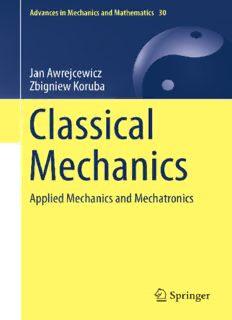Table Of ContentAdvances in Mechanics and Mathematics
Volume 30
SeriesEditors:
DavidY.Gao,VirginiaPolytechnicInstituteandStateUniversity
RayW.Ogden,UniversityofGlasgow
RomeshC.Batra,VirginiaPolytechnicInstituteandStateUniversity
AdvisoryBoard:
IvarEkeland,UniversityofBritishColumbia
TimHealey,CornellUniversity
KumbakonamRajagopal,TexasA&MUniversity
TudorRatiu,E´colePolytechniqueFe´de´rale
DavidJ.Steigmann,UniversityofCalifornia,Berkeley
Forfurthervolumes:
http://www.springer.com/series/5613
Jan Awrejcewicz (cid:129) Zbigniew Koruba
Classical Mechanics
Applied Mechanics and Mechatronics
123
JanAwrejcewicz ZbigniewKoruba
DepartmentofAutomation DepartmentofComputer-basedTechnologies
andBiomechanics andArmamentEngineering
Ło´dz´UniversityofTechnology KielceUniversityofTechnology
Ło´dz´,Poland Kielce,Poland
ISSN1571-8689 ISSN1876-9896(electronic)
ISBN978-1-4614-3977-6 ISBN978-1-4614-3978-3(eBook)
DOI10.1007/978-1-4614-3978-3
SpringerNewYorkHeidelbergDordrechtLondon
LibraryofCongressControlNumber:2012940871
©SpringerScience+BusinessMedia,LLC2012
Thisworkissubjecttocopyright.AllrightsarereservedbythePublisher,whetherthewholeorpartof
thematerialisconcerned,specificallytherightsoftranslation,reprinting,reuseofillustrations,recitation,
broadcasting,reproductiononmicrofilmsorinanyotherphysicalway,andtransmissionorinformation
storageandretrieval,electronicadaptation,computersoftware,orbysimilarordissimilarmethodology
nowknownorhereafterdeveloped.Exemptedfromthislegalreservationarebriefexcerptsinconnection
with reviews or scholarly analysis or material supplied specifically for the purpose of being entered
and executed on a computer system, for exclusive use by the purchaser of the work. Duplication of
this publication or parts thereof is permitted only under the provisions of the Copyright Law of the
Publisher’slocation,initscurrentversion,andpermissionforusemustalwaysbeobtainedfromSpringer.
PermissionsforusemaybeobtainedthroughRightsLinkattheCopyrightClearanceCenter.Violations
areliabletoprosecutionundertherespectiveCopyrightLaw.
Theuseofgeneraldescriptivenames,registerednames,trademarks,servicemarks,etc.inthispublication
doesnotimply,evenintheabsenceofaspecificstatement,thatsuchnamesareexemptfromtherelevant
protectivelawsandregulationsandthereforefreeforgeneraluse.
While the advice and information in this book are believed to be true and accurate at the date of
publication,neithertheauthorsnortheeditorsnorthepublishercanacceptanylegalresponsibilityfor
anyerrorsoromissionsthatmaybemade.Thepublishermakesnowarranty,expressorimplied,with
respecttothematerialcontainedherein.
Printedonacid-freepaper
SpringerispartofSpringerScience+BusinessMedia(www.springer.com)
Preface
Thisisthethirdandfinalvolumeofatriadofbooksdevotedtoclassicalmechanics;
it uses the theoretical background presented in Classical Mechanics: Kinematics
and Statics and Classical Mechanics: Dynamics. It is focused on presenting
a unique approach, rooted in classical mechanics, to studying mechanical and
electromagnetic processes occurring in applied mechanics and mechatronics. In
contrast to the majority of books devoted to applied mechanics, this volume
places particular emphasis on theory, modeling, and analysis and control of
gyroscopicdevices, includingmilitaryapplications.Thisbookprovidespracticing
mechanical/mechatronic engineers and designers, researchers, and graduate and
postgraduatestudentswithaknowledgeofmechanicsfocuseddirectlyonadvanced
applications.
Chapter1dealswithdynamicsinmechatronicsystems.Aunifiedapproachbased
on mechanics and variational calculus is applied first to the study of dynamical
processes in electromechanical systems, henceforth referred to as mechatronic
systems.InSect.1.1,theconstitutiverelationsofelementsofelectriccircuitssuch
asresistors,coils,capacitors,andinductorsareintroduced,andtwoofKirchhoff’s
lawsarepresentedintheformoftwotheorems.Then,theapplicationofHamilton’s
principle and the Lagrange equations to electrical (electromagnetic) systems is
described. An illustrative example is also presented. In Sect.1.2, dynamical pro-
cessesinmechatronicsystemsarestudied.TheLagrangeequationsformechatronic
systemsarederived.Thenvariousmechatronictransducersaredescribed,including
resistive-displacementtransducers,resistance-basedsensors,inductivetransducers,
capacitive and angular velocity transducers, temperature transducers, thermocou-
ples, pressure transducers, magnetoelectric sensors and piezoelectric transducers.
A single mechatronic system is also studied, and the magnetic force magnitude
is derived. In Sect.1.3, magnetic levitation is analyzed. A levitating cylindrically
shaped rigid body is studied experimentally, and the governing equations of the
body levitating in magnetic and gravitational fields are derived. Two cases of
the numerical control are studied, and the numerical examples are presented. In
Sect.1.4, dynamics of the string-type generator is studied. Governing equations
consist of a PDE and ODE with time delay, and they are analyzed using the
v
vi Preface
averagingapproachandnumericalsimulation.Lastly,Sect.1.5studiesthedynamics
ofarotorsupportedbyamagnetohydrodynamicbearing.Bothresonanceandnon-
resonancecases,aswellasrotorchaoticdynamicsareanalyzed
InChap.2,thedynamicsofa rigidsphericalbodyisstudiedwithemphasisput
on applications. In Sect.2.1, the kinematics of a rigid body is revisited including
the Euler and Cardan angles. In Sect.2.2, the kinematic energyof a rigid body is
defined and equationsof the spherical motion of a rigid body are given. Here the
Eulerand Lagrangecases are studiedmoreextensivelyin comparisonto the book
Classical Mechanics: Dynamics. The same applies to the Kovalevskayacase, and
theessenceofthegyroscopiceffectisoutlined.
Chapter3isdevotedtothetheoryofgyroscopes.InSect.3.1,anhistoricaloutline
ofthetheoryofgyroscopesisgiven.InSect.3.2,elementsofgyroscopeclassifica-
tion are introduced,and then the evolutionof the gyroscopeconceptis presented.
Milestones in gyroscope development are highlighted in Sect.3.4. In Sects. 3.5–
3.9,thefollowinggyroscope-typedevicesareconsidered:thedirectionalgyroscope,
the gyroscopic vertical, the stabilized gyroscopic platform, the laser gyroscope,
thefiber-opticgyroscope,thepiezoelectricgyroscope,theforkgyroscope,andthe
microgyroscopewithaspinningdiskandwithavibratingring.Section3.10contains
examplesofdevicesforgyroscopicnavigation.Anexampleofanobservationdevice
withabuilt-ingyroscopeisprovidedinSect.3.10.InSect.3.11,newchallengesfor
thegyroscopearebrieflysummarized.
Chapter4isdevotedtothedynamicsandcontrolofgyroscopes.InSect.4.1,the
dynamicsofthegyroscopeonamovableplatformisdescribed.Thentheequations
ofmotionofthegyroscopeaxisandthegyroscoperotorarederived.Theparticular
caseofastaticgyroscopeplacedonafixedplatformwiththeaxisfixedtotherotor
is studied. Finally, a technical equation of gyroscope motion and some remarks
regarding the modeling of gyroscope dynamics are outlined. Gyroscope control
is presented in Sect.4.2. First, an inverse problem of gyroscope dynamics, i.e.,
motion control of the gyroscope axis in an open-loop system is studied and a
numericalexampleisprovided.Then,controlwithconstantprogrammablemoments
is discussed and clarified through an illustrative numerical example. Section 4.3
deals with motion control of the gyroscope axis in a closed-loop system. First, a
gyroscopicsystemwithaPIDcontrollerisconsidered,anditsstabilityisanalyzed.
Then,aregulatorwhoseroleistominimizeerrorsbetweentheprescribedandactual
motionsis introducedinto the gyroscopecontrolsystem. In Sect.4.4, selection of
optimal parameters of a gyroscopic system in an elastic suspension is carried out
anditsoptimalcontrolisstudied.Section4.5focusesontheselectionoftheoptimal
parametersofa gyroscopesystem with an axisfixedto the rotor;thissection also
includestheoptimizationofaclassicallycontrolledgyroscope.
In Chap.5, gyroscopic control in self-guidance systems of flying objects is
presented.InSect.5.1,agyroscopecontrolinanunmannedaerialvehicleisstudied.
First,thenavigationkinematicsofanunmannedaerialvehicleisanalyzed,andthen
thecontrolofagyroscopefixedonitsboardaswellasitsfullcontrolarediscussed.
A gyroscope in a guided aerial bomb is studied in Sect.5.2, which includes an
analysis of the kinematics of a bomb self-guided motion to a ground target, the
Preface vii
equations of motion of a guided bomb, and a description of a gyroscopic system
devotedtobombcontrolincludingautomaticpilotcontrol.
TheauthorswishtoexpresstheirthankstoMr.P.Da¸bekandMr.M.Kaz´mierczak
for their help in the book’s preparation. J. Awrejcewicz acknowledges also the
hospitality of the Fraunhofer Institute of the Technical University of Darmstadt
duringhisresearch,madepossiblebytheAlexandervonHumboldtAward.
Kielce,Poland ZbigniewKoruba
Ło´dz´,Poland JanAwrejcewicz
Contents
1 DynamicsinMechatronicSystems......................................... 1
1.1 DynamicalProcessesinElectricCircuits............................. 2
1.1.1 ConstitutiveRelationsofElementsofElectricCircuits..... 2
1.1.2 ApplicationofHamilton’sPrinciple
andLagrange’sEquationstoElectricalSystems ............ 6
1.2 DynamicalProcessesinMechatronicSystems....................... 13
1.2.1 MechatronicTransducers ..................................... 15
1.2.2 MagneticForceinaSingleMechatronicSystem............ 26
1.3 MagneticLevitation ................................................... 32
1.3.1 TheAnalyzedSystem......................................... 33
1.3.2 TwoCasesofNumericalControl............................. 34
1.4 String-TypeGenerator................................................. 37
1.4.1 AnalyzedSystem.............................................. 38
1.4.2 AveragingMethod............................................. 39
1.4.3 NumericalAnalysisandResults.............................. 43
1.5 RotorSupportedbyMagnetohydrodynamicBearing................ 50
1.5.1 MathematicalModel .......................................... 53
1.5.2 SoftMagneticMaterials....................................... 56
References..................................................................... 85
2 EquationsofMotionofaRigidSphericalBody.......................... 87
2.1 KinematicsofRigid-BodyMotion ................................... 87
2.1.1 TheEulerAngles.............................................. 87
2.1.2 CardanAngles................................................. 93
2.2 KineticEnergyofaRigidBody ...................................... 97
2.2.1 EquationsofSphericalMotionofaRigidBody............. 98
2.2.2 TheEulerCaseandGeometricInterpretation
ofMotionofaBodybyPoinsot.............................. 103
2.2.3 LagrangeCase(PseudoregularPrecession).................. 110
ix
Description:This is the last book of three devoted to Mechanics, and uses the theoretical background presented in Classical Mechanics: Kinematics and Statics and Classical Mechanics: Dynamics. It focuses on exhibiting a unique approach, rooted in the classical mechanics, to study mechanical and electromagnetic

